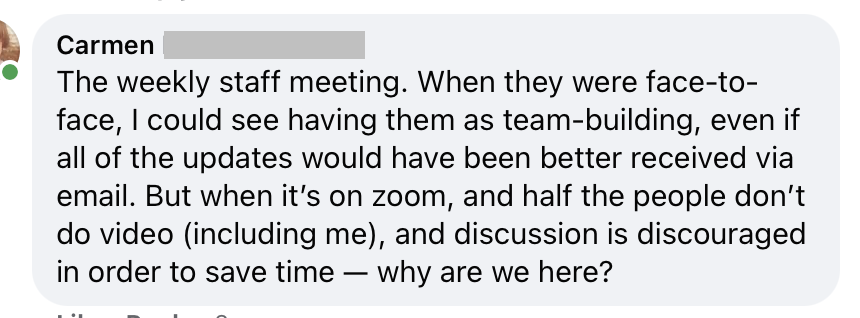Time is too precious to schedule meetings that could have been an email. Follow these guidelines to avoid this costly mistake.

It’s critical to run your meetings well. It’s important to your project. And it’s a great way to showcase your leadership skills.
But even if you make an effort to run better meetings, it’s also important to make sure you’re not scheduling an unnecessary meeting. That would be a huge waste of time for your team. And I can’t count the number of times I’ve overheard a coworker say, “I’ve got to get out of these meetings so I can get some work done!”
So before you schedule that next meeting, stop to consider if you even need it.
There are times when you may be holding meetings that could have been an email.
Related: How to Take Great Meeting Notes (Template and Samples)
Holding unnecessary meetings is worse than you think
At a time when productivity is a hot topic, there’s one improvement you may be missing.
Pulling team members into meetings during the day has a huge cost.
- Everyone in that room (or on that call) is earning a salary – and all those salaries during those hours in your meetings add up.
- Your participants will miss the chance to focus on more meaningful work when they’re sitting in unproductive meetings.
- Adding unnecessary meetings during the day results in context shifting when they’re shifting their attention across multiple different focus areas. This causes team members to lose focus, time, and effort toward valuable work.
- Your coworkers hate those unnecessary meetings and may come to associate those negative feelings with you, too.
Now that you’re hopefully convinced to cut back on meetings you don’t need, learn which ones can be replaced with email instead.
The following list will help. Read through it so you can ask yourself if you need to schedule that next meeting – or simply send a message instead.
Related: Improve Your Meetings with This One Simple Step
Not all communications require a meeting – sometimes an email is all you need. Before you schedule that next meeting, ask yourself if you could accomplish the same goal with an email instead.
5 Meetings That Could Have Been an Email Instead

For additional perspective, I asked friends about their experiences with meetings that could have been an email. I share their stories so you can see how much people dislike attending these unnecessary meetings. And yes, they notice!
1. Getting feedback

A friend told me she had a boss that used to call meetings to go over documents – line by line – for feedback. It happened often and was excruciating. My friend said “we could have done this online. She could have shared a link to the document in an email, and we could have easily given feedback that way.”
If you need to get input from a coworker or team on something you can share outside a meeting, by all means, start there. Post your document to a location that others can access, or simply attach it to the email letting them know what type of feedback you’re looking for.
There are several benefits to this approach:
- You’ll get more honest opinions. People will likely share an idea in private they wouldn’t in a group.
- You’ll get higher quality information. People won’t feel so rushed and will be able to give their full attention.
- You’ll get better feedback by avoiding groupthink – that tendency to think as a group and get consensus among participants.
After your team sends their thoughts, you can meet to discuss if needed.
2. Status updates that don’t require action

Maggie: Pretty much every meeting I attend. In particular, status update meetings. All the updates are in the gosh dang spreadsheet, and we just go around the table, virtual or otherwise, and read what’s on the spreadsheet. Some people just LOVE to hear themselves talk.

Martin: Most meetings from my management could have been an email. They oftentimes do not add value but are disguised to hide how confused management is about what is going on. …I really think these kinds of meetings are related to the fact that they just don’t understand what they are reading from the emails they receive … even though they are the ones that ask us to send them those emails… They asked for a status via email. Then it gets discussed during the biweekly meeting.
If you’re sharing or requesting information as a status update you can easily do this via email. If you need more information or clarity, ask for this in a follow-up email – or even pick up the phone and make a call.
When you do need a status meeting, read this: How to Create a Project Status Meeting Agenda [Free Template]
3. Sharing information

Carmen: The weekly staff meeting. When they were face-to-face, I could see having them as team-building, even if all the updates would have been better received via email. But when it’s on zoom, and half the people don’t do video (including me), and discussion is discouraged in order to save time — why are we here?

If you’re giving information to your team one-way with no need for input or dialogue, you can do this via email.
Two situations when you may need to hold a meeting:
- If management or executives see this as a way to be available to their teams, it can be a good use of time. Sharing information and giving attendees the opportunity to ask questions can build morale and help the team feel more supported.
- If leadership is sharing sensitive information that could negatively impact morale, it helps to deliver it in person.
4. No clear goals or outcomes

Janet: OMG too many to mention. Usually, they came about because the host didn’t have an agenda, or structure – so their meetings would drone on, or go over – rather than hashing it out in an email then taking those ideas into the meeting to discuss.

If you don’t have a clear objective, goals, outcomes, or even an agenda, you’ve got more work to do. Communicate via email to get the information you need rather than pulling people together to “wing it” in a meeting. It may be that you never needed that meeting.
And if you do need a group discussion or working session, spend the time to clearly understand the intended goals and outcomes of your meeting.
This article can help: Improve Your Meetings with This One Simple Step
5. No changes since the last meeting.

If you hold a project meeting on a cadence and have no new information, progress, or changes since the last meeting – with nothing to discuss – please send an email with this update and let everyone have that time for other work. They’ll thank you for it.
Improve your communications for better results
My friend John shared his thoughts on this: Nearly every meeting could be an email if two conditions are met: 1. The manager has strong enough writing skills to clearly communicate; 2. The co-workers are disciplined enough to read, process, carefully consider, and email follow-up questions about what was written. These two conditions are rarely met.
While I don’t agree that nearly every meeting could be an email, John makes some helpful points:
- In your communication, be clear with your message. if you’re sending information to inform, organize the information in a way that makes it easy for readers to understand.
- If you’re asking for something, such as feedback, be clear in what you’re asking for, and include due dates or other important information.
Summary
You’ve worked hard to run better meetings. But there’s another improvement to consider.
Next time you open your calendar to schedule a meeting, ask yourself if you really need one.
You should have a clear objective and goal for your meeting. You may be able to accomplish that goal with an email instead. You’ll schedule fewer meetings, and your team will appreciate getting those hours back.
If you want the step-by-step guide for how to run the most amazing meetings that get results and get you noticed, get my book Bad Meetings Happen to Good People: How to Run Meetings That Are Effective, Focused, and Produce Results.



What about emails that could be a meeting/ video call instead? Some people tend to write long emails only and cc: many, and it ends up 10+ email exchange just to resolve a matter where a 5-15 minute meeting could have been instead.
Hi Leigh, we also hate meetings which waste everyone’s time. So much that we wrote a meeting 101 guide, and meeting policy template. What do you think about it: [Link deleted]?